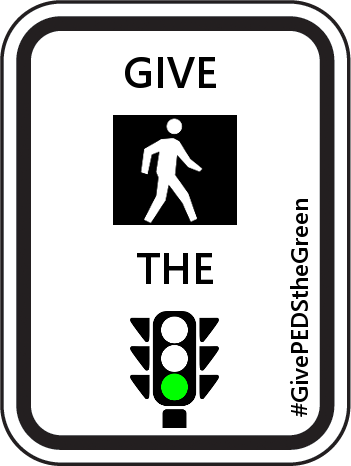A petition in Seattle is calling on the city to do away with "beg buttons" and automatically give pedestrians a walk signal at every traffic light in its "urban villages" -- areas that are walkable and transit-oriented.
Tom Fucoloro at Seattle Bike Blog is an enthusiastic supporter of the idea, which was launched over at the website the The Urbanist by activist Troy Heerwagen. The plan would cost almost nothing to implement while improving walkability and safety.
While pressing a beg button may seem like a small imposition, it's not that simple, especially if you can't see very well. Fucoloro once saw from afar how difficult it was for a visually impaired person to locate the button:
The whole time he was searching for the button (it was on a third smaller pole closer to the intersection), the traffic signal had been going through its regular cycles for people driving but kept skipping the walk signal, which “chirps” to tell people with vision impairments which direction has the walk.
This intersection is one of the many, many intersections in the city where the walk signal will only be shown if someone pushes a button commonly (and perfectly) called a “beg button.” By skipping the walk signal, traffic engineers are able to add a few seconds to green lights, thus maximizing vehicle throughput.
But the cost of those extra seconds falls on people walking, who are inconvenienced at best and put at increased health risk at worst.
The man with the vision impairment I saw is a particularly egregious case showing how these buttons can cause some community members serious problems just because they can’t see which of the nearby poles has a button. But as I sat back down with my coffee fuming at how insensitively this cold and distant traffic signal program had just treated this man, I began to notice that sighted and able-bodied people were also being put in unfair and potentially dangerous situations.
Over and over, people arrived at the corner and either didn’t notice the button or didn’t push it early enough to get the walk. Once they realized that the light was green and they were getting skipped, they had two choices: Wait another minute or so for the cycle to come back around (which makes walking take longer than it should, decreasing the appeal) or make a run for the other side, hoping to get to there before traffic on Union got the green.
Predictably, most people who were physically able ran for it. Because of course they did. It’s “their turn,” or at least it should be.
We all know this feeling because it happens all the time all over the city. But it doesn’t need to be this way. It forces people to make a quick, tough decision between two unappealing options. And if they try to cross too late, the results could be tragic.
Fucoloro says Seattle Mayor Ed Murray plans to reprogram a number of traffic signals around the city to improve pedestrian safety. With this push from residents for safer signals, hopefully the city will be compelled to take things further.
More recommended reading today: Greater Greater Washington takes a look at which areas of the DC region are truly "suburban" and which are truly "urban," and it doesn't match up too well with the political boundaries people typically use to make the distinction. And Price Tags shares a video that explains "induced demand," or why adding more road capacity doesn't reduce congestion.






